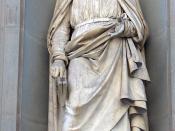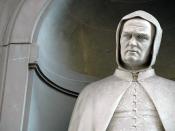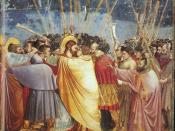Giotto crossed a barrier painters before him could not. In fact with his teacher, Cimabue, the two are often regarded as the founders of modern painting. The question at hand is found in this very foundation, as Giotto had a sort of "naturalness" in his paintings that others lacked, as Giovanni Boccaccio stated. This essay will then explore the reasoning of Boccaccio, in an attempt to portray the view of this 14th Century Florentine humanist.
Likewise, I will give my opinion of Giotto's work. As a contemporary, I find Giotto's work to be quite unnatural, therefore my critique must be taken with a grain of salt, knowing that as plain as Giotto's work may seem to people today, at his time he painted in a revolutionary style, completely new to his fellow Florentines.
A century after Giotto's death, Boccaccio wrote that Giotto's genius looked not so similar to a work of nature as to a work by nature herself.
What then was the "naturalness" that Boccaccio saw in Giotto's painting alone? To begin with, Giotto painted people and angels in a rounder, more life-like fashion than his predecessors. This new geometric perspective led Boccaccio to believe that Giotto's paintings looked less like photographs than actually reality. It lies in this personification that Giotto, before all others, was able to capture the illusions of real life, in terms of emotion and space, on a flat surface. The most effective study of Giotto's work is the Arena Chapel, where over forty of his frescos cover the wall and ceiling. To Boccaccio who would have viewed this work first hand, not frame by frame with the use of a slide machine or on a computer screen, the feeling and emotion emitted would have been...


